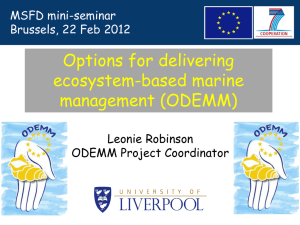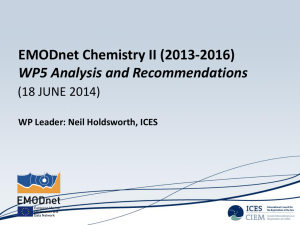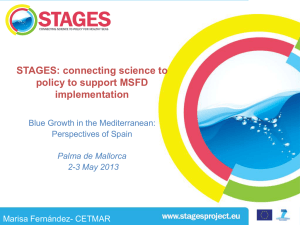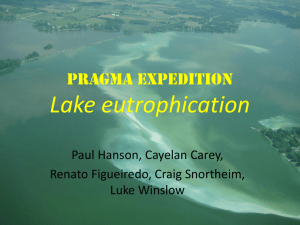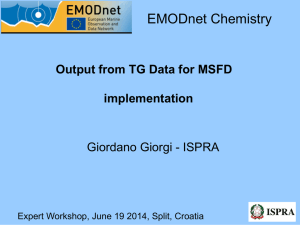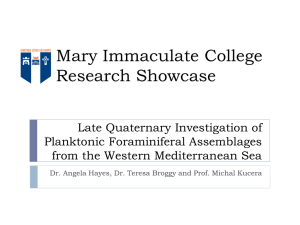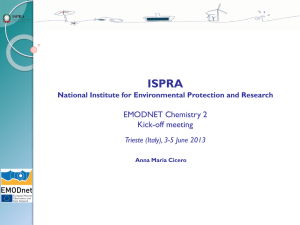Giannoudi_EMODNETchem_Split
advertisement
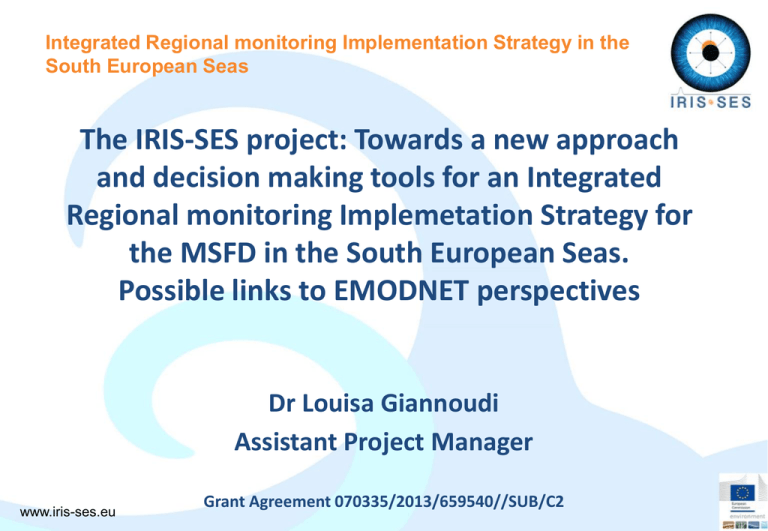
Integrated Regional monitoring Implementation Strategy in the South European Seas The IRIS-SES project: Towards a new approach and decision making tools for an Integrated Regional monitoring Implemetation Strategy for the MSFD in the South European Seas. Possible links to EMODNET perspectives Dr Louisa Giannoudi Assistant Project Manager www.iris-ses.eu Grant Agreement 070335/2013/659540//SUB/C2 Pilot Project - New Knowledge for an integrated management of human activities in the sea (PP/ENV D2/SEA 2012) Launched in autumn 2012 Overall amount available under this Call is 2.000.000 € from the European Parliament 3 proposals have been funded (1 for SES, 1 for BS, 1 for NS/CS) Starting date: 1 Oct 2013 Duration: 18 months Target: A new approach and decision making tools for an integrated marine monitoring for the MSFD in order to support an effective management of anthropogenic activities in marine waters (specifically of the Mediterranean and Black Seas, as selected pilot areas for IRIS-SES) General objectives: Development of: • integrated monitoring strategies build on running monitoring programs • multidisciplinary monitoring guidelines and integrated ecosystem surveys • strategic approaches to monitor anthropogenic pressures • integrated monitoring tools and programs at sea regions scales • Planning for JMPs in pilot regions of the under study regional seas, based whenever possible on existing monitoring programs, looking for their optimization, to improve their adequacy to MSFD sampling requirements Specific objectives of IRIS-SES: Develop decision-making tools to design efficient and cost effective monitoring programs Consider possibilities for the integration of techniques and determine the required spatial and temporal resolution Assess, through pilot sampling actions within existing monitoring programs, the feasibility of proposed integrated monitoring strategies Elaborate guidelines for sampling across the various disciplines (biological, chemical, physical) to meet the MSFD requirements Development of cooperation among research institutions within selected regions in the implementation of pilot projects Training events Transfer of knowledge to other regions IRIS-SES activities take in account : the activities/results of on-going projects related to MSFD and other EU Directives, such as: MISIS, PERSEUS, EMBLAS/UNDP, CREAM, COCONET, DEVOTES, EMODNet, SeaDataNet, My Ocean, BONUS, MEDITS, MEDIAS, MEDISEH, etc. other standards and initiatives as: Integrated Maritime Policy (IMP) for EU, Common Fisheries Policy (CFP), Ecosystem Approach Management (EAM), Global Monitoring for Environment and Security (GMES), etc Regional Conventions as: Bucharest, Barcelona, OSPAR, HELCOM Directives: WFD, Habitat, Birds, INSPIRE Results and Recommendations by: Descriptors Task Groups, IAs, EEA IRIS-SES partnerships IRIS-SES has 5 activities (WPs): Activity 1: Analysis of the monitoring programs carried on the framework of European/Regional/National legislation in relation to MSFD requirements (leader: NIMRD) • • • prepare a catalogue and a comprehensive analysis of the existing monitoring programs related to European Directives, Regional Sea Conventions and other national or international programs in the Mediterranean and Black Seas in order to assess the contribution of these programs to meeting MSFD needs and to assess pressures and to achieve better knowledge on the gaps and on understanding of the needs and constraints This work is ongoing and will be implemented as the project progresses Two main axes where considered in order to build up the catalogue: 1) Indicators axis focus on: prioritization of needs for all Directives - end up in integrative tools indicators, taking into account experience in metric and indices development (as in WFD). harmonization in regional or sub-regional level taking into account IAs of MSs for MSFD indicators-methods and PERSEUS and MISIS output/suggestions. consider new indicators developed/tested under current MSFD related Projects (PERSEUS, DEVOTES, CoCoNET, etc) 2) Spatial axis focus on: preparation of an "extended" coastal network of existing monitoring for WFD to MSFD. available data from satellites and models (should be integrated in the spatial axis) periodicity and spatial scale (should also been taken into account for all relevant Directives) Task 1.1a: The inventory Inputs collected in the framework of different existing surveys, observation platforms and EU projects as follows: –All running national monitoring projects in the Mediterranean and Black Seas –WFD implementation –EU Directives - Habitats and Bird, Bathing waters, Urban waste water, Nitrates, Shellfish waters. –Ballast water management Convention –Common Fisheries policy – data collection –EU projects – e.g. PERSEUS, MISIS –Other relevant observation platforms (REACH - Registration, Evaluation, Authorization and Restriction of Chemical substances - regulation RSC: Barcelona and Bucharest Conventions and associated Protocols; WISE Water Information System for Europe; EEA, etc. First IRIS-SES deliverable T1.1a – Inventory of the MP - the catalogue of the monitoring programs carried on six MS: from Black Sea (Romania, Bulgaria) and from Mediterranean Sea (Greece, Cyprus, Italy, Spain) and one candidate country, Turkey (with monitoring both in the Black Sea and Mediterranean Sea). The catalogue has 7 Excel Files comprising of 17 sheets grouped as follows: D1,4,6 – Birds; D1,4,6 – Mammals,;D1,4,6 – Fish; D1,4,6 – Seabed habitats Phytobenthos;D1,4,6 – Seabed habitat Zoobenthos; D1,4,6 – Water column habitats Phytoplankton; D1,4,6 – Water column habitat Zooplankton; D2-NonIndigenous species; D3-Commercial Fish and Shellfish, D5 – Eutrophication; D7 – hydrographical changes; D8 – contaminants in water; D8-contaminants in sediments; D8-contaminants in biota; D9-contaminants in seafood; D10-marine litter; D11-energy&noise. Example of the xls inventories The example is on data collected biodiversity-seabed habitats for Greece Two RSCs were considered (UNEP MAP and BSC). Each file consists of 17 worksheets developed to answer to art.11 MSFD requirements. Columns inside consist of general information but also … On parameters information specific to related descriptor/programme/subprogramme T1.1b – Meta database - All the information from the catalogue was aggregated into one (meta) database, consisting of one excel file, planned to be compatible with larger oceanographic/environmental databases like SeaDataNet and EMODNET through the use of INSPIRE and SeaDataNet standards. T1.2 – Analysis of pressures consists of • the Inventory and critical assessment of international and regional legislation developed under two excel sheets which include the review of significant regional and international regulatory bodies which may contain monitoring obligations, and which may be linked to monitoring programmes already implemented by the countries beneficiaries of the IRIS-SES Project. • socio-economic characterization of principal human activities influencing marine ecosystems among Mediterranean and Black Sea countries. • future trends in human activities, current pressures and future pressures resulting from human activities in the Mediterranean and Black Seas concerns future trends expected for socioeconomic activities in the Mediterranean and Black Seas, as well as current and future expected environmental pressures, and links with impacts. • considerations on the need for monitoring data to support future assessments and managerial actions - identifies data gaps and at highlights monitoring needs regarding environmental pressures, in order to guide monitoring efforts and support the development of coherent future joint monitoring programmes. T1.3 – Assessment of the Monitoring Programmes •Up to now, the dataset has been completed for 5 countries (Bulgaria, Greece, Italy, Romania, Turkey). This analysis does not take into consideration datasets that have been partially completed. The full assessment, has been moved under Activity 2 and will be presented in the next reporting period. . Activity 2: Integrating scales of monitoring with those of processes to be monitored (leader Univ.Salento) Assess existing marine monitoring programs across states (EU, non EU), within regions/subregions, to cover MSFD requirements addressing ~all descriptors Assess opportunities to develop further existing programs and infrastructure (including platforms, surveyors on ship of opportunity, spare capacity, buoys, remote sensing tools etc) and assessment of the MSFD indicators covered into multidisciplinary programmes. Assess geographical coverage of monitoring programmes, demonstrate overlaps, choose parameters to measure in order to provide the data to allow the assessment methods to classify if a marine area is reaching the desired status. Identification of overlaps, gaps and needs in the required monitoring Geographical coverage of the existing monitoring programs, location of sampling sites and periodicity of sampling Example of seabed habitat PhyB Monitoring stations for which is available a record complete of geographical coordinates and sampling frequency (excluding stations for which the proposed sampling frequency is 'as needed' or 'irregularly' or 'one-off’ .Countries not included in the maps did not provide a complete record for any station. Activity 3: Adaptation and development of intelligent tools (leader HCMR) The tools will have a major interactive role in monitoring planning and functioning across countries. They will also reveal the gaps needed to be covered for a full assessment under the requirements of MSFD. The tools will serve in management planning and measures implementation. The GIS rationale is to develop: a basic set of information layers to be used as generic information for all 11 MSFD Descriptors in-deep approach for selected Descriptors and incorporate intelligent tools specially designed for those Descriptors The decision-making tool rationale is to provide: a simple, intelligent tool, to support policy makers, managers, and stake-holders. Eutrophication GIS Tool for IRIS-SES Main objectives Assessment of Environmental status related to Eutrophication - MSFD D5 Calculation and visualization of eutrophication indices Unified platform for Western, Eastern Mediterranean and Black Sea Addressed to scientists, decision makers, not necessary experts in eutrophication issues Materials - Development tools Model builder – ArcGIS 10.2 Toolboxes – ArcGIS 10.2 Python Programming Language 2.7 Product Eutrophication Status Toolbox Eutrophication Indices (I) 1. Eutrophication Index (EI) Required Data: Mean annual or seasonal concentrations of PO4, NO3, NO2, NH3, Chl-α (μg/L) (mean integrated values of both water column and time) Eastern Mediterranean Ε.Ι. = 0.279CPO4 + 0.261CNO3 + 0.296CNO2 + 0.275CNH3 + 0.214CChl-α Eutrophication status < 0.04 0.04 - 0.38 0.38 - 0.85 0.85 - 1.51 > 1.51 2. BEAST Black Sea Oligotrophy Mesotrophy Eutrophication Classes according to requirements of WFD High Good Moderate Poor Bad (Primpas et al., 2010) 3. TRIX Eutrophication Indices (II) Required Data: Mean annual or seasonal concentrations (mean integrated values of both water column and time) of Chl-α D%O2 TN PO4 : Chl-α concentration (μg/L) : The % deviation of the oxygen concentration from saturation conditions Required data of Temperature, Salinity, Dissolve Oxygen, water density - T, S, DO, d : Mineral nitrogen; Dissolved Inorganic Nitrogen, DIN = N(as N − NO3 + N − NO2 + N − NH4) as μg/L : Total inorganic phosphorus as P–PO4 as μgr/L Eastern Mediterranean (Primpas et al. 2011) will be included ... Western Mediterranean – Adriatic (Pettine et al., 2007) TRIX = [Log10(PO4*TN*Chl-α*D%O2)+α]/b The parameters a = 1.5 and b = 1.2 are scale coefficients, (proposed by Giovanardi and Vollenweider 2004) to fix the lower limit value of the index and also to fix the scale range from 0 to 10. Black Sea ? Proposed scaling 2-4 4-5 5 -6 6-8 >8 Eutrophication status Ultra oligotrophic Oligotrophy Mesotrophy Eutrophic Dystrophic Classes according to requirements of WFD High Good Moderate Poor Bad Geodatabase: Background features/main geographic layers - Visualization of the monitoring programme inventory of Greece - Descriptors in GIS Background features for Mediterranean and Black Sea INPUT FROM EXISTING EU DATA BASES AND GENERIC LAYERS FREELY AVAILABLE e.g. Environmental European Agency, My Ocean, Emodnet, Environmental Systems Research Institute, Projects, Papers Main geographic layers • Coastline • Topography & Bathymetry • Water bodies (WFD) • Monitoring stations (WFD) •• Marine Protected Areas • Nationally designated areas (Protected area CDDA) • Natura sites Sites for Habitats Directive and Birds Directive • Habitats (e.g. Posidonia meadows, marine caves, coralligenous formations) • Ferries traffic Background features for Mediterranean and Black Sea The second group of background features are ocean and atmospheric processes that include: • Sea level rise • Hydrodynamics of mean tidal amplitude • Temperature • chlorophyll • Salinity • Current velocity • Dissolved Oxygen Monitoring Programmes According to the activity 1 of IRIS-SES project it has been displayed the Greek inventory of monitoring programmes, which is incorporated into the descriptors one of ten of the MSFD. • Descriptor 1: Biodiversity • Descriptor 2: Non-indigenous Species • Descriptor 3: Commercial Fish and shellfish • Descriptor 4: Food Webs • Descriptor 5: Eutrophication • Descriptor 6: Sea-floor Integrity • Descriptor 7: Hydrographical Conditions • Descriptor 8: Contaminants • Descriptor 8: Contaminants • Descriptor 9: Contaminants in Seafood • Descriptor 10: Marine Litter • Descriptor 11: Energy incl. Underwater Noise Task 3.2: DeCyDe-4-IRIS, the decision making tool ISOTECH ISOTECH’s approach is for developing DeCyDe-4-IRIS as a strategic decision support method experts and key actors involvement and engagement tool and a self- assessment tool for GES MAJOR QUESTION: how to assess the status of each parameter/ feature that will be monitored and set the targets in order to achieve GES. Involvement and commitment of key actors and stakeholders, through their active participation is a pre-requisite for the success of any effort. The DeCyDe-4-IRIS method will be developed for two descriptors (5 and 8/9), and will be implemented in two pilot areas: the Saronikos Gulf in Greece and Constanta in Romania. Activity 4: Optimization and adaptation to MSFD requirements of ongoing joint marine monitoring in the Mediterranean and Black Sea: planning the future JMPs (Activity leader: IEO) Objectives To elaborate detailed, realistic and affordable joint monitoring plans for the Mediterranean and Black Sea regions, useful for the achievement of MSFD objectives, resulting from the optimization and integration of existing international monitoring programs. In addition to carry out a series of pilot studies within the framework of some of the existing JMP identified To present a plan for the design and implementation of new joint standardised monitoring programs specifically focused on filling the gaps in MSFD monitoring needs in the Mediterranean and Black Sea regions that cannot be addressed through the optimisation of existing international programs. Task 4.1: Develop JMP from existing monitoring Task 4.2: Pilot study 4.2.1 To develop additional samplings during night hours within the framework of the MEDITS survey in the Balearic Sea 4.2.2 Under the existing RADMED monitoring program implement a mooring line close to a position routinely visited under RADMED, to complement the temporal gaps between visits to decrease the signal-to-noise ration in “the seasonal and interannual evolution of temperature, salinity, turbidity and currents on the whole water column Task 4.3- Strategic Plans for ongoing JMPs – IEO & Univ. Salento Task 4.4: Strategic Plans for designing new JMPs – IEO & HCMR However the preparation phase has started on tasks 4.2 and 4.4. Activity 5: Coordination and Management, Dissemination and Sustainability (leader: HCMR) Objectives are to: Coordinate activities Manage and monitor the progress of the project Ensure the project meets its objectives within the time and the budget limits Facilitate communication between partners • Link IRIS-SES to other international and national projects • Link IRIS-SES to stakeholders (4 local stakeholders workshops - W. Medit, C. Medit, E. Medit, and Black Sea - and a final stakeholders conference are planned) Communicate and outreach Project results and scientific developments on all levels of society: policy, public as well as scientific community Food for thought What IRIS-SES wants from EMODNET chemistry? Data on monitoring, maybe even on cruises Feeling our gaps Join our stakeholder meetings (info on potential dates will be available possibly mid July) What EMODNET chemistry wants from IRIS-SES? Again exchange of data Harmonisation of available monitoring programmes? What else? What is necessary to do for policy-decision makers? How is this information could be translated to help on establishing GES according to MSFD requirements? Thank you for your attention ! For more information: Project Coordinator: Kalliopi Pagou HCMR popi@hcmr.gr Tel. +30 22910 76409 Project Manager: Nikos Streftaris - nstrefta@hcmr.gr Assistant Manager Louisa Giannoudi – lgiannoudi@hcmr.gr www.iris-ses.eu
